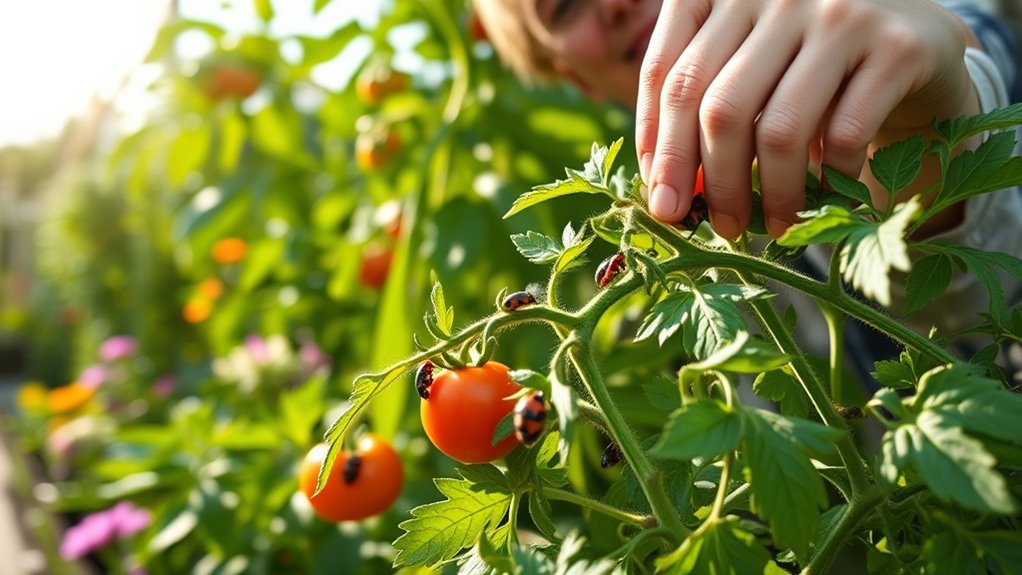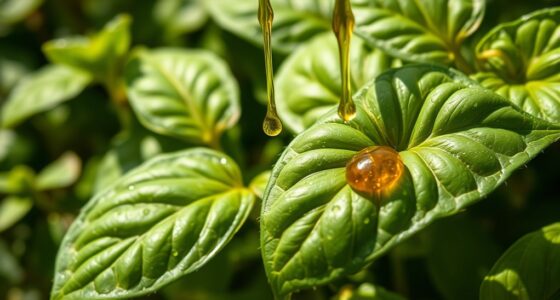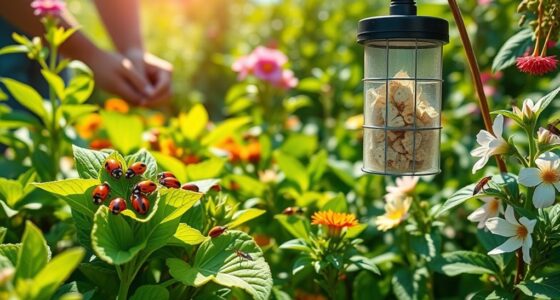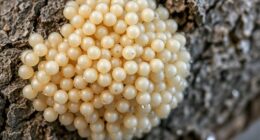Integrated Pest Management (IPM) is a smart, sustainable approach that helps you control pests in your garden by combining biological, cultural, mechanical, and chemical methods. It focuses on monitoring pests regularly, using natural enemies like beneficial insects, and implementing practices like crop rotation or resistant plants. Chemical controls are only used as a last resort and in a targeted way. Keep exploring to discover how to apply these strategies for a healthier, thriving garden.
Key Takeaways
- IPM combines cultural, biological, and chemical methods to manage pests sustainably and minimize environmental impact.
- It relies on regular pest monitoring to detect issues early and guide timely interventions.
- Biological controls, like beneficial insects, are prioritized to naturally reduce pest populations.
- Chemical pesticides are used only as a last resort and in a targeted manner to limit harm.
- Overall, IPM promotes healthy, resilient gardens by reducing chemical dependence and supporting ecological balance.
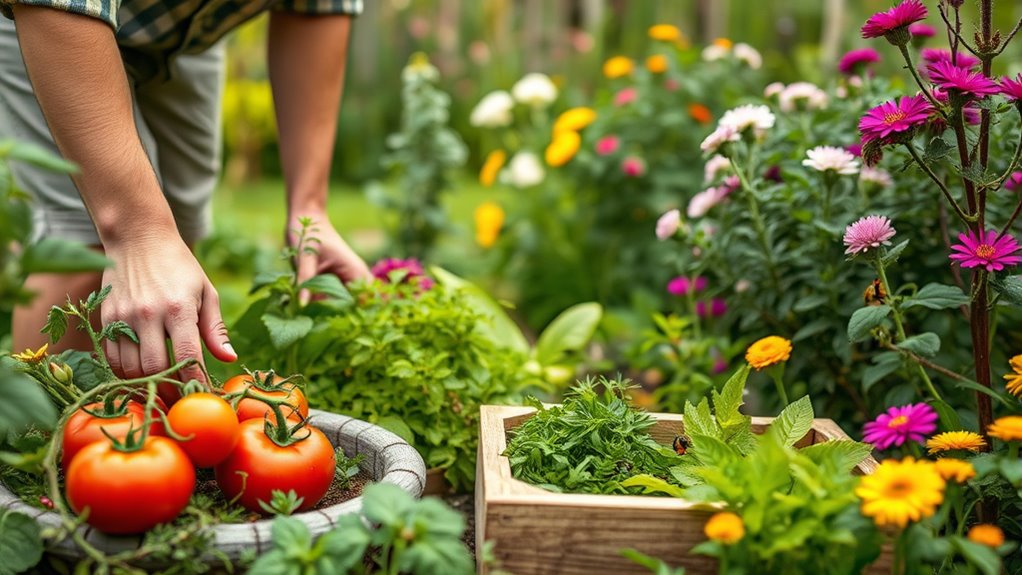
If you’re looking for an effective way to control pests in your garden without relying solely on chemicals, integrated pest management (IPM) offers a smart, eco-friendly solution. IPM combines different strategies to keep pest populations under control while minimizing harm to beneficial organisms and the environment. Instead of spraying broad-spectrum pesticides, you focus on understanding pest behavior, monitoring their presence, and applying targeted interventions. This approach not only protects your garden’s health but also promotes sustainable gardening practices.
A key component of IPM is pest monitoring. Regularly inspecting your plants helps you identify pest issues early before they become overwhelming. You look for signs like chewed leaves, discolored spots, or the presence of pests themselves. With consistent pest monitoring, you gain valuable data on pest population levels and their life cycles. This information guides your decisions about when and how to intervene, ensuring you don’t treat problems prematurely or unnecessarily. Monitoring also helps you track the effectiveness of your control methods, allowing adjustments if pests persist or new issues arise. Incorporating an understanding of natural materials used in farmhouse bedrooms highlights the importance of eco-friendly practices, mirroring the principles of IPM.
Biological control is another essential aspect of IPM. It involves using natural enemies of pests—like predatory insects, parasitic wasps, or beneficial nematodes—to keep harmful populations in check. Introducing or encouraging these beneficial organisms in your garden can considerably reduce pest numbers without resorting to chemical pesticides. For example, releasing ladybugs to control aphids or introducing nematodes to target soil-dwelling pests provides a natural, sustainable way to manage pests. Biological control emphasizes working with nature rather than against it, creating a balanced ecosystem where pests are kept in check naturally.
Implementing IPM begins with proper pest monitoring to determine if and when intervention is necessary. When pest populations reach a threshold where damage could become significant, you then select the most appropriate control method—often starting with biological controls or cultural practices like crop rotation, planting resistant varieties, or adjusting watering schedules. Chemical controls are used only as a last resort and in a targeted manner to minimize environmental impact. This integrated approach ensures that pest management is effective, environmentally responsible, and sustainable in the long run.
Frequently Asked Questions
How Does IPM Differ From Traditional Pest Control Methods?
You’ll notice that IPM differs from traditional pest control because it minimizes chemical reliance and avoids broad spectrum pesticides. Instead of spraying everything with harsh chemicals, you focus on targeted strategies like crop rotation and biological controls. This approach reduces environmental impact, protects beneficial insects, and keeps your garden healthier. Traditional methods often rely on quick fixes with broad spectrum pesticides, which can harm non-target organisms and lead to resistance over time.
What Are the Most Common Pests Managed With IPM?
Imagine your garden as a bustling city, where pests like aphids, caterpillars, and beetles threaten your peace. With IPM, you manage these common pests by encouraging beneficial insects such as ladybugs and lacewings, and planting pest-resistant plants. This eco-friendly approach reduces chemical use, keeping your garden healthy and balanced. You take a proactive stance, protecting your plants naturally while maintaining a vibrant, thriving garden environment.
Can IPM Be Used in Organic Gardening?
Yes, you can use IPM in organic gardening because it emphasizes organic compatibility and maintains soil health. You actively monitor pests and choose natural or organic methods to control them, avoiding synthetic chemicals. This approach supports your goal of sustainable, healthy soil, and reduces environmental impact. IPM’s flexibility allows you to adapt strategies that align with organic standards, helping you manage pests effectively while preserving your garden’s organic integrity.
How Long Does It Typically Take to See Results With IPM?
You might wonder how long it takes to see results with IPM. Timing expectations vary depending on success factors like pest type, severity, and your approach. Generally, you could notice improvements within a few weeks if you stay consistent and monitor regularly. Patience is key, as integrated strategies often lead to long-term pest control. Keep tracking your progress, and you’ll see gradual but steady results over time.
Are There Any Safety Concerns for Children or Pets With IPM?
Imagine your kids and pets as tiny explorers wandering through your garden’s safety zone. With IPM, you can rest easy knowing it’s designed to prioritize child safety and pet protection. It minimizes chemical use, reducing risks of harmful exposure. While no method is entirely risk-free, IPM’s focus on natural solutions and targeted treatments keeps your loved ones safe, making your garden a secure playground rather than a hazardous zone.
Conclusion
By embracing integrated pest management, you’re taking the bull by the horns and tackling pests head-on with smart, eco-friendly strategies. Remember, patience and persistence are key—sometimes you need to wait for the right moment to act. Keep a close eye on your garden, stay proactive, and don’t be afraid to adapt your approach as needed. With consistent effort, you’ll find that pest problems become more manageable, proving that slow and steady truly wins the race.
